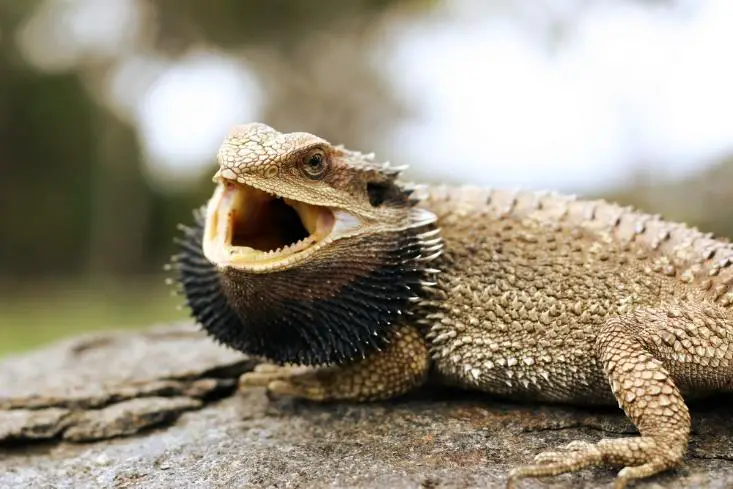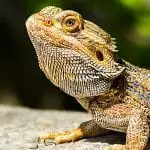Bearded Dragons look like a dragon, and they are equipped with an armor of spiny reptilian scales that includes a “beard” of spikes that under the chin that is puffing up depending on what mood it has. The Bearded Dragons have eight species that are recognized as of to the present. These eight kinds or species of Bearded Dragons are called “Beardies.”
Bearded Dragons belong to the family of reptilia of the reptiles, and these bearded dragons tend to be active, inquisitor, and gentle during the day. The most common species have as a pet is the central bearded dragon Pogona vitticeps.
Thebehavior of Bearded Dragons
The Bearded Dragons are known for being territorial. The adult bearded dragons can display their aggression to fight for food, compete for a female, and to defend their turf from other males.
Here are the good-to-know facts about the behavior of bearded dragons:
- Some male bearded dragons may also attack the females if they don’t show the behavior. The beard that both male and female bearded dragons have is an important way for the lizards to communicate.
- When a bearded dragon is threatened, it tends to raise its chin, open its mouth and puff out its beard just to make itself appear bigger. This kind of behavior displayed by the bearded dragon may also be accompanied by a hiss.
- By changing the color of their beards and bobbing their heads is also a way for the bearded dragon to communicate with each other. A quick head bob of a bearded dragon may signal dominance and a slow bob and an arm wave of a bearded dragon is a sign of submission
- A bearded dragon may go through education because of the change of seasons. Brumation is a type of hibernation in which stops eating and only drink water sporadically. This kind of dormant phase happens or occurs in the fall or winter as there is a change in light, and there is the dropping of the temperature.
Habitat of Bearded Dragons
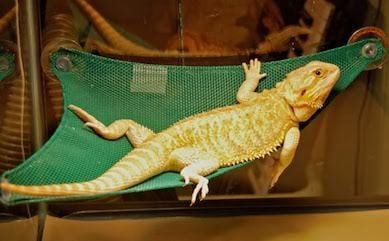
Bearded dragons typically prefer to stick or to live in warm places, arid areas just like in deserts, subtropical woodlands, scrublands, and savannas. It is crucial for the bearded dragons to have a warm habitat.
Bearded dragons are cold-blooded animals, and they do rely on external heats just to raise their body temperatures, and of course, it varies with the temperatures of the environment. These bearded dragons tend to live in places that are not too cold and not too hot for them to live longer.
Diet of a Bearded Dragon
The bearded dragons are not a picky eater, and they can clench and crush their prey that are hard-shelled insects like beetles using their strong jaws. Bearded dragons are indeed omnivores.
That’s why they also go eat flowers, leaves, occasional small lizards or rodents, vegetables these of course fruits. The bearded dragons are much likely to eat this for their health and for them being much more healthy, for they are always in the wild.
Why Bearded Dragons Open Their Mouth While Basking?
Gaping is what you call when a bearded dragon opens its mouth while basking. Basking is basically when a bearded dragon is sitting with his or her mouth open instead of it being closed under the sun.
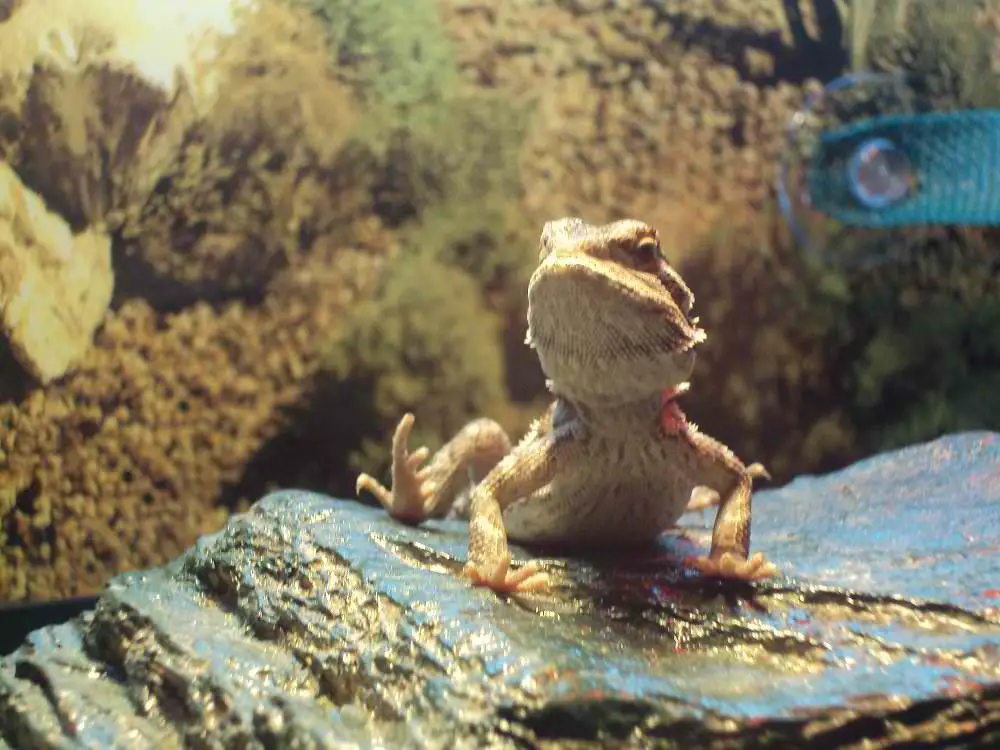
Here are the reasons why bearded dragons tend to open their mouth when basking:
- When a bearded dragon is regulating his or her temperature is the most common reason why they open their mouth while they are basking. Bearded dragons do not sweat like humans. That’s why they control their body temperatures by opening their mouth whenever they feel that they reach their own ideal body temperature and if they do not want to get any hotter.
- Bearded dragon normally does this when they are basking underneath the sun. It is their way to relieve their bodies into stress, and also it is their way of having relaxation. Having a respiratory infection or respiratory disease can also be one reason why the bearded dragons open their mouth.
- Since being the mouth is a very common behavior, a bearded dragon does it, which is normally just a sign that a bearded dragon is just regulating its body heat or its body temperature.
- Many owners of bearded dragons do not realize how warm this lizard should really be maintained. That’s why the owners do not see this kind of behavior of a bearded dragon. Having a basking spotlight is the key to keep the bearded dragons happy because it allows them to raise their body temperature 95(ninety-five) to 100(one-hundred) degrees Fahrenheit.
Normally bearded dragon sits with its mouth open when they reach their thermal maximum. It shows that the lizard is already at its optimal temperature for basking. In order to allow a bearded dragon to dissipate extra body heat, they need gaping. This is a very effective way for the bearded dragon to regulate their body heat or their body temperature.
What Pet Owners Can Do?
It’s very important for a bearded dragon to have a thermal gradient on their habitat in order for them to move into cooler locations if they wanted once they reached their optimum body temperature. Any dragon that is kept at the right temperature will frequently gape while they are basking. It is a form of thermoregulation in which all of the excess heat that is vented upon basking out of the mouth of the bearded dragon, it is their first defense against overheating.
While humans sweat, on the other hand, the bearded dragons gape. This gaping, however, is not a sign of discomfort within the bearded dragons. In fact, the bearded dragon does this to prevent heat build-up once a bearded dragon achieved the perfect internal temperature due to the personal ventilation technique of the bearded dragons, not too cold and not too hot. The bearded dragon is a happy bearded dragon while it is gaping.
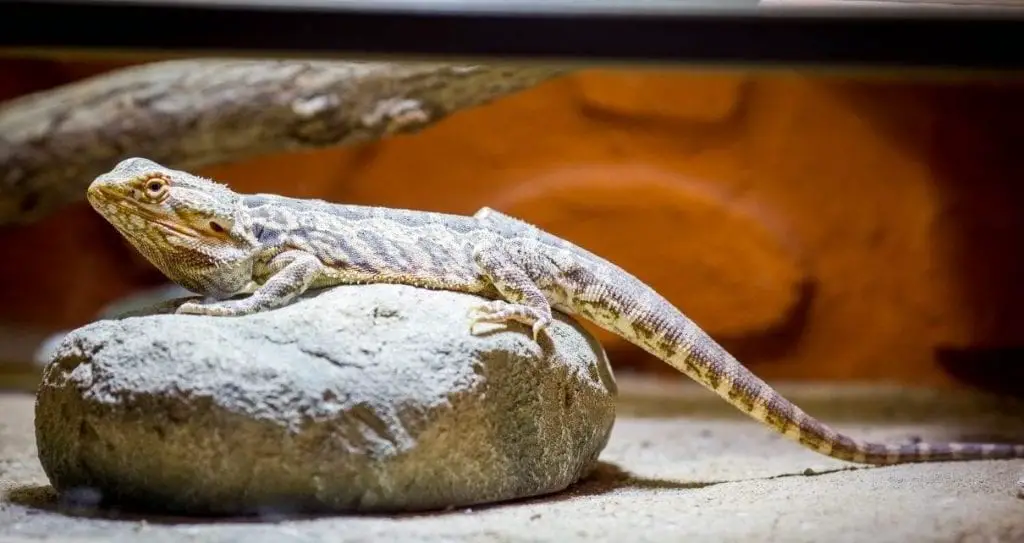
What Is Basking?
Basking is to lie in or to be exposed to the pleasant warmth of the sun. To bask in the sun means to relax outside and enjoy the sunlight, not necessarily to get a tan. Basking is when a bearded dragon is to sit in a rock or anything to bask or to get some heat on them under the sun.
Signs of Aggression of Bearded Dragons
Generally, by nature, bearded dragons are not aggressive, which makes them a very good pet. The worst thing is that when a bearded dragon is provoked too much, they might bite that shows a sign of aggression. Bearded dragon being aggressive is somewhat alarming that it can harm its owner and people around it.
Signs That a Bearded Dragon Is Aggressive
Fluffing Their Beard or Bearding
This behavior is where the bearded dragon got its name. It is a sign of a threat when a bearded dragon fluffs its beard. Fluffing its beard is obviously making a bearded dragon look much bigger and more threatening that becomes a sign of aggression. When a bearded dragon is bearding, sometimes their beard becomes darker or even becomes a black color.
Hissing
If a bearded dragon feels that he or she is somewhat threatened, he or she will hiss to protect his or her life. It’s another sign of being uncomfortable or a sign of aggression in a bearded dragon. Hissing is also a sign that the bearded dragon feels uncomfortable with the environment that he or she is in. It shows that the bearded dragon feels threatened and that it needs to do something that will protect its life.
Biting
Obviously, it’s a sign of aggressiveness. Not handling your pet or your bearded dragons’ aggressiveness will just put you in danger. So what you need to do is that you need to take and wear gardening gloves in order to protect you from the bite of the bearded dragons when they try to bite you. Not doing so will only prevent you from developing a closer bond with your pet or with your bearded dragon.
Head Bobbing
When a bearded dragon bobs its head up and down, it is a sign of territorial aggression towards the other animals. It is also a sign that you must not take another step towards its territory. Bobbling their heads towards each other is also a sign of communication between a bearded dragon to a bearded dragon.

Conclusion
The behaviors that a bearded dragon just shows how unique they were and how they were as a pet or as an animal. Bearded dragons are always and very genuine because they do not mimic the other bearded dragons. When there is a female bearded dragon, most of the male bearded dragon shows this kind of behavior and also when there is another that comes near to them or whenever they were approached by larger or bigger animals or something that is unknown. Bearded dragons are also scared of anything in the wild; that’s why if anything that is suspicious in the environment, they tend to do this behavior.

